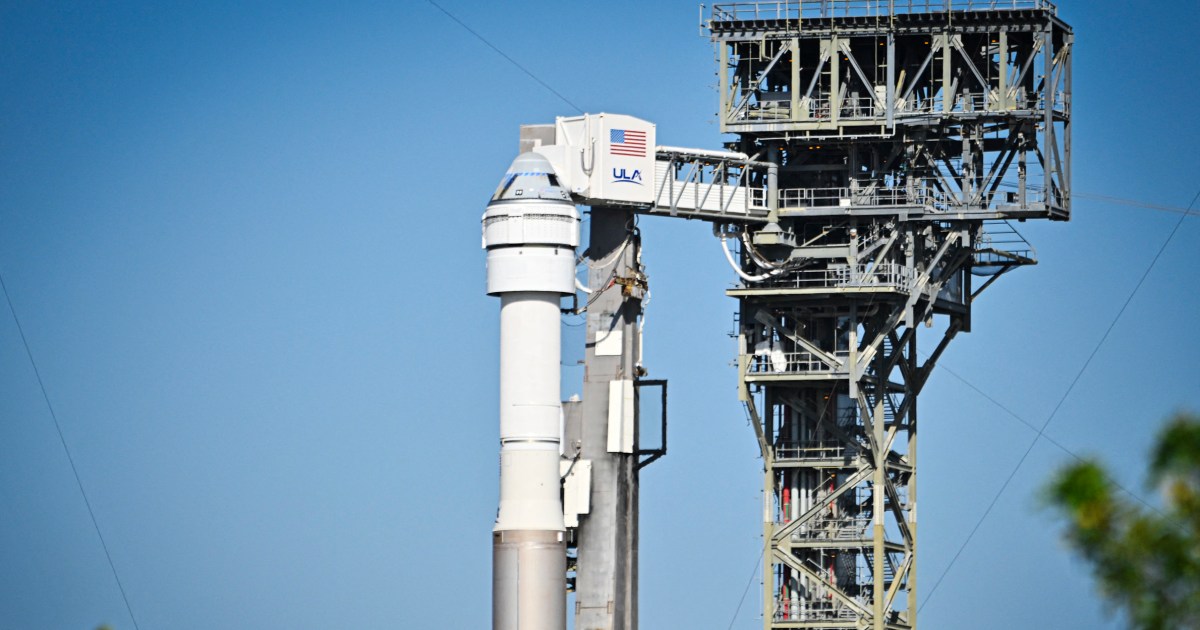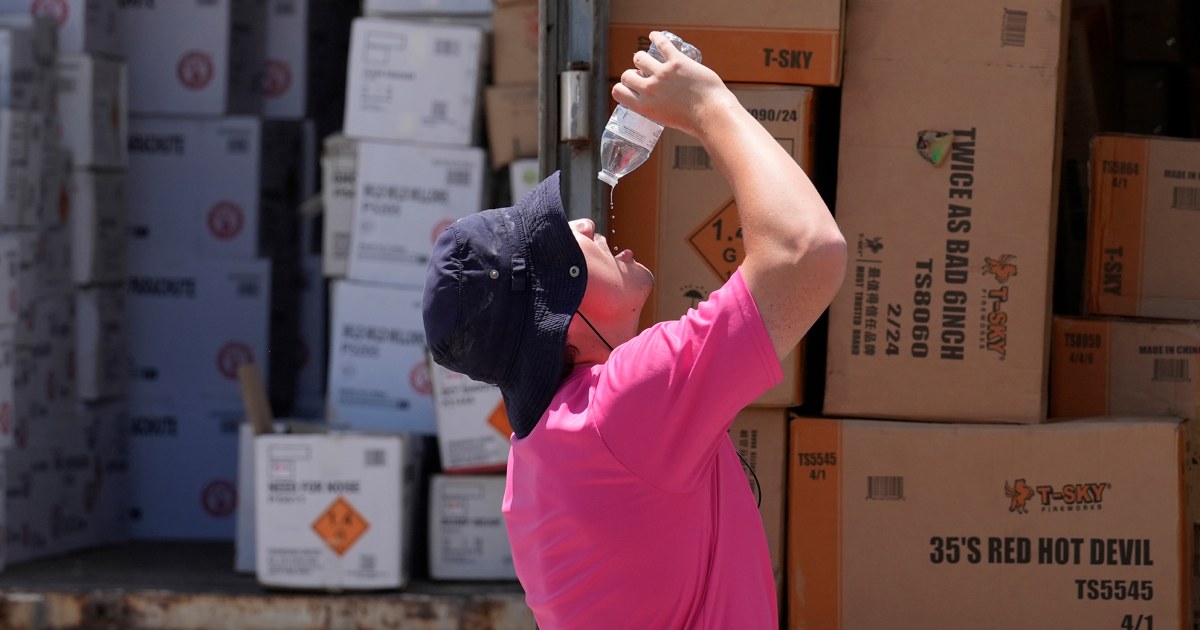A (distant) view of launch pad 41
Reporting from Cape Canaveral, Florida
Here’s our view from the roof of the NBC News building with less than 30 mins to go until launch. You can see Cape Canaveral’s Space Launch Complex 41 in the distance to the far right, where Starliner is planned to launch.
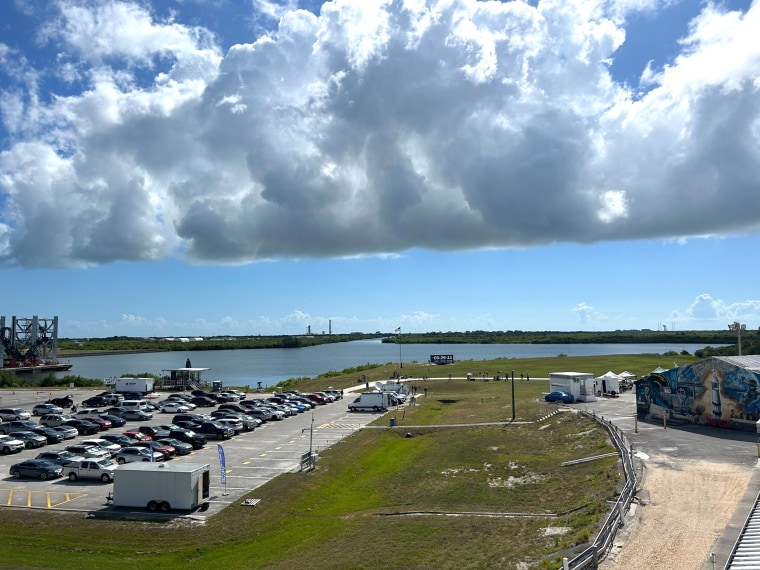
25 minutes to launch
We’re roughly 25 minutes away from the scheduled launch time for Starliner.
Keep in mind, plenty of checks still have to happen, and the mission could be scrubbed again.
Still, looking good so far.
The first 31 minutes of flight
Things will get especially exciting in the first few minutes of flight.
Forty-five seconds after liftoff, the Starliner capsule and its crew will reach what’s known as Max Q, or the maximum dynamic pressure that they will experience during ascent into orbit. This occurs right around when the spacecraft reaches Mach 1, the speed of sound.
At 11 minutes and 58 seconds into flight, the capsule will reach orbit. A few minutes later, the Starliner spacecraft will separate from the upper stage of the rocket and start flying on its own.
Thirty-one minutes into flight, the Starliner capsule will conduct a burn that will put it into a slightly elliptical orbit on its way to the International Space Station.
Spot the rocket
Even if you aren’t in and around Cape Canaveral, Florida, you may still be able to spot the Atlas V rocket as it carries the Starliner capsule to space.
The booster will be launching on a “flat and long” trajectory up the Eastern Seaboard, according to Tory Bruno, president and CEO of United Launch Alliance, which manufactures the Atlas V rocket. That means people all along the southern coast of the U.S. have a good chance of seeing the rocket on its way into orbit, he said.
Testing the Starliner capsule’s manual mode
During this upcoming flight, the astronauts will perform a number of tests to show that the Starliner capsule can safely ferry crew members to and from low-Earth orbit.
Boeing’s spacecraft is designed to fly autonomously, but the astronauts will take the controls at various points to demonstrate the capsule’s handling and to practice emergency scenarios.
As the capsule approaches the space station, it is designed to autonomously dock with the orbiting outpost, but Wilmore and Williams again plan to test its manual controls tomorrow on their final approach.
SpaceX’s Crew Dragon capsule, which has been flying regular crewed flights to the space station since 2020, flies and docks on its own but has manual controls that can be activated, if necessary.
Meanwhile, in Texas…
Boeing is not the only one with a much-anticipated launch this week.
SpaceX is scheduled to conduct a fourth, uncrewed test flight of its Starship megarocket tomorrow. It will occur at SpaceX’s Starbase test site in Boca Chica, Texas, with a target launch window that opens at 8 a.m. ET.
Starship is the most powerful rocket ever developed. The upcoming flight aims to test technologies and techniques that will be key on future missions to the moon. In particular, SpaceX is hoping to demonstrate the reusability of the Starship system by showing that the upper-stage spacecraft and the rocket’s first-stage booster, known as Super Heavy, can make controlled and safe re-entries through Earth’s atmosphere.
Starship was selected by NASA to carry astronauts to the lunar surface for the agency’s Artemis III mission, which could launch in 2026.
What to expect
As the countdown clock ticks closer to liftoff, here’s what to expect.
The astronauts are now strapped into their seats and the Starliner capsule’s hatch is closed. A series of leak checks will be performed, then the “crew access arm” — the suspended walkway used to access the capsule — will retract away from the spacecraft.
Next, various teams of mission controllers will conduct a “go-no go” poll to confirm that all systems are ready for liftoff. Then, it’s all up to the Atlas V rocket to light and take the Starliner capsule and its crew to space.
After launch, there will be a number of key milestones to keep an eye on. Around 15 minutes after liftoff, the Starliner capsule will separate from the upper stage of the rocket. Roughly 16 minutes after that, the spacecraft will conduct a burn to help it reach a stable orbit.
What’s inside the Starliner capsule
This mission is a test flight but the Starliner capsule is packed with nearly 800 pounds of cargo to take to the International Space Station.
Most importantly, the spacecraft is carrying a new pump for the space station’s urine processor assembly, which filters and recycles urine and other wastewater, turning it into safe drinking water.
The capsule is also loaded with mission patches, pins, American flags, collectible coins and a hard drive loaded with thousands of pieces of artwork made by children from around the world. The astronauts have packed along some personal items for family and friends, and some other surprise items will be revealed during the mission, according to NASA.
The press assembles
Reporting from Cape Canaveral, Florida
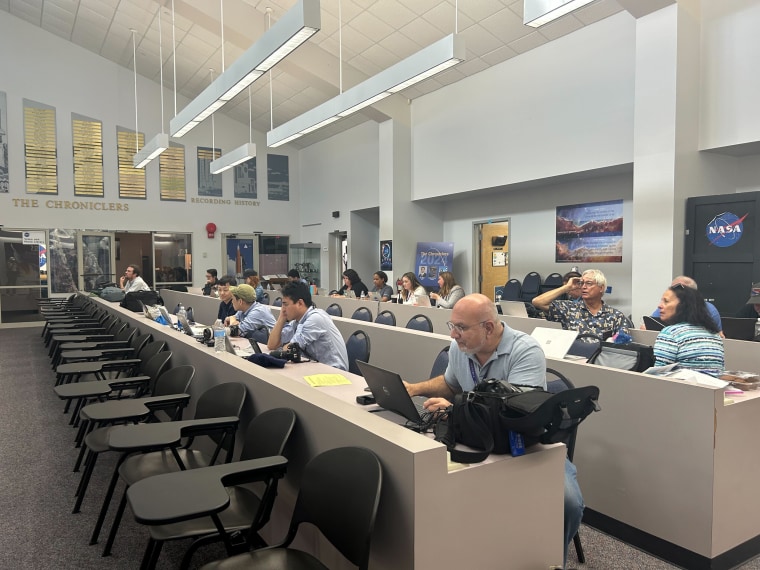
We’re setting up here at the NBC News building and the parking lot is getting more full with members of the media.
About two hours before launch, there were already about 15 tripods set up for live shots down by the countdown clock, and members of the Kennedy Space Center media team and members of the press were making preparations.
Closing the hatch
Personnel are now closing the hatch of the Starliner capsule.
“See you in a couple weeks,” one team member radioed to the astronauts in the spacecraft.
Next, the capsule will be pressurized to check for any leaks.
Aerial views of the rocket
All eyes are on the launch pad as preparations continue for a scheduled 10:52 a.m. ET liftoff.
From the oceans to the cosmos
The astronauts are bringing a small, sequined narwhal toy with them to space. The toy was chosen to be their “zero-gravity indicator,” which serves as a visual indicator that the Starliner capsule has reached the weightlessness of microgravity.
Look for the narwhal to be floating around the spacecraft (on a tether!) when the crew reaches orbit.
Getting buckled in
Astronauts Butch Williams and Sunita Williams are getting strapped into their seats inside the Starliner capsule. Another round of spacesuit leak checks will be performed, and teams will make sure the crew members can reach all of their controls and communicate with mission managers on the ground.
The Starliner craft is relatively roomy, as far as space capsules go. The interior is roughly equivalent to a midsize SUV, according to NASA.
Weather looks good for launch
Weather conditions are 90% favorable for liftoff this morning.
Teams are monitoring the possibility of cumulus clouds forming around the launch pad closer to launch time, but NASA officials said the threat is currently low. It’s dangerous to launch through puffy cumulus clouds because that can trigger a lightning strike, which would endanger the astronauts onboard.
Beyond Florida, mission managers also need to keep an eye on weather conditions all along the rocket’s ascent corridor up the Eastern Seaboard. This is because there are points along that path where, if something were to go wrong, the Starliner capsule could abort and separate off the top of the rocket before splashing down in the Atlantic Ocean.
A family affair
Reporting from Cape Canaveral, Florida
In an interview hours before Saturday’s launch attempt was called off, Sunita Williams’ mother, Bonnie Pandya, told NBC News that her daughter was in good spirits.
“She’s very upbeat. She’s so happy about going,” Pandya said. “She loves it.”
Pandya said she expects her own emotions will run high when her daughter finally lifts off.
“When it goes, I’ll get very emotional,” Pandya said. “She’s my beautiful little girl — the baby of the family.”
Rock, paper, scissors…
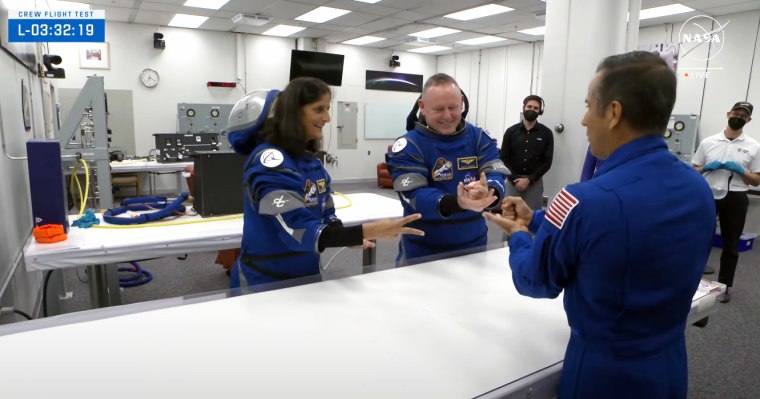
Before heading to the launch pad, Wilmore and Williams are playing a game of “rock, paper, scissors” with Joe Acaba, chief of the Astronaut Office. This is a new take on an old tradition of playing a game of cards before launch, dating back to the space shuttle era.
The goal is to lose the games before heading to the launch pad. Why? Because the astronauts are effectively leaving their bad luck behind on Earth before lifting off.
Rocket is fueled and ready to go
NASA officials say that the Atlas V rocket is now fully fueled at the launch pad.
Astronauts Butch Wilmore and Suni Williams are finishing up leak checks on their spacesuits before they head to the launch site.
Fellow astronaut Michael Fincke, who trained with Wilmore and Williams as the mission’s backup pilot and is conducting live commentary for this morning’s launch, said the crew members are ready to fly.
“We’ve been waiting for over five years to get Starliner launched, but they are very, very excited about today,” Fincke said. “You can see that they’re focused on getting the job done and they are very ready for this mission, and they wish all of us a great experience in joining them on this great journey.”
Medical checks cleared
Boeing said early this morning that the astronauts have cleared medical checks.
Meet the astronaut crew
NASA astronauts Barry “Butch” Wilmore and Sunita Williams are set to make history as the first crew members to fly aboard the Starliner capsule.
Wilmore and Williams are both veteran astronauts and former test pilots in the U.S. Navy. NASA selected the pair in 2022 for Boeing’s first crewed test flight.
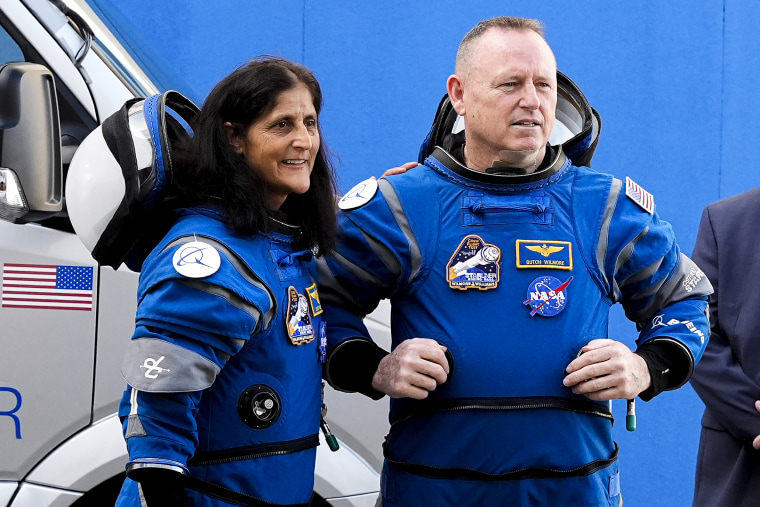
Wilmore, the mission’s commander, has completed two previous spaceflights, logging 178 days in space. A Tennessee native, he piloted the space shuttle Atlantis to the space station in 2009, and also launched to the orbiting outpost aboard a Russian Soyuz spacecraft in 2014 as a member of the space station’s Expedition 41 crew.
Williams, the mission’s pilot, previously completed two stints aboard the International Space Station, totaling 322 days in space. She grew up in Needham, Massachusetts, and first flew to the space station on the space shuttle Discovery and remained there for about six months.
In 2012, Williams returned to space, this time in a Russian-built Soyuz spacecraft. Her second stay on the space station lasted roughly four months.
Why this flight is important
The Starliner’s crewed test flight is required for Boeing to show that its spacecraft can safely carry astronauts to and from the International Space Station.
Rival company SpaceX has been conducting routine flights to the space station with its Crew Dragon capsule since 2020. Boeing is hoping that a successful test flight will help it catch up to SpaceX and will provide NASA with a long-awaited second option.
Boeing’s Starliner and SpaceX’s Crew Dragon were both developed as part of NASA’s Commercial Crew Program, which was launched more than a decade ago to support the creation of new, privately built space vehicles to fill the void left when the agency retired its space shuttles.
Third time’s a charm?
It’s launch day for Boeing’s Starliner spacecraft!
This will be the third attempt to launch the capsule on its first flight with a crew onboard, following repeated delays, so the event should be closely watched.
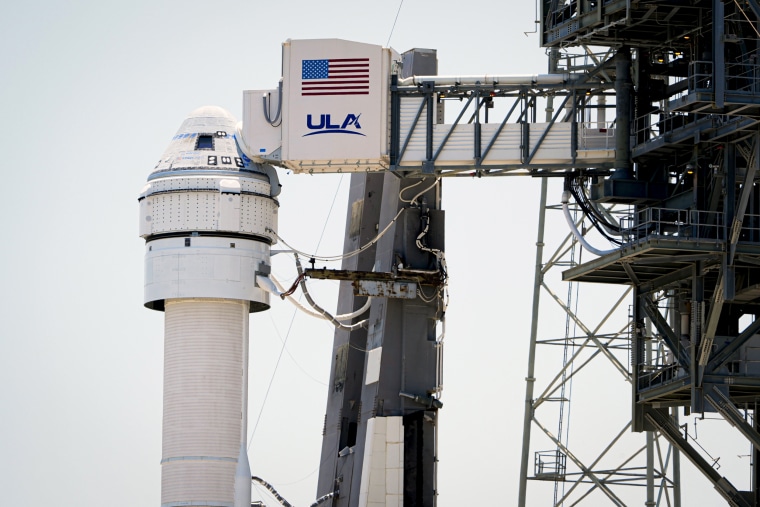
The Starliner completed an uncrewed test flight to the International Space Station in 2022, paving the way for it to carry astronauts. But its first try at a crewed launch, on May 6, was scrubbed with about two hours remaining in the countdown due to an issue with a valve on the rocket. A helium leak was later found in the capsule’s propulsion system, which led to further delays.
Then on Saturday, a second launch attempt was called off with less than four minutes to go before liftoff, after an automatic abort was triggered by one of the computers that controls the Atlas V rocket on which the Starliner rides to space. The rocket is manufactured by United Launch Alliance, a joint venture of Boeing and Lockheed Martin.
Those setbacks followed years of delays and budget overruns in Boeing’s Starliner program, so the stakes are high today.




